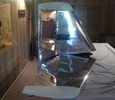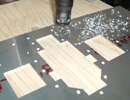


random user submitted photo
Ken's Sonex 1243
Ken's Sonex 1243
First attempt at this posting thing.
Right wing coming together, still need to finish pilot drilling the rest of the upper aft wing skin to the main spar, only drilled every other hole to get it down. A few shots of the "march of the cleco's" that so many folks have also shared. I hope the other side and leading edge go as smooth. Not quite sure how I am going to approach the re-leveling of the wing once it is time to flip for the other skin.



Right wing coming together, still need to finish pilot drilling the rest of the upper aft wing skin to the main spar, only drilled every other hole to get it down. A few shots of the "march of the cleco's" that so many folks have also shared. I hope the other side and leading edge go as smooth. Not quite sure how I am going to approach the re-leveling of the wing once it is time to flip for the other skin.



Ken S
SONEX #1243 N424SX (reserved)
Tail complete, wings done
Fuselage on gear
Jab 3300 received!
SONEX #1243 N424SX (reserved)
Tail complete, wings done
Fuselage on gear
Jab 3300 received!
- Sonex1243
- Posts: 312
- Joined: Thu Jan 08, 2015 4:59 pm
Re: Ken's Sonex 1243
Finished upsizing the right wing upper skin. Also pilot drilled and upsized the larger hinge for aerobatic ailerons. Took it off the table and placed on the saw horses to pilot and upsize the aileron bellcrank channels to the skin. Gathering some wood to use for blocking / re-leveling of the wing on the table for the lower aft skin installation since the cleco's will now be in the way once turned over.



Thanks for viewing.



Thanks for viewing.
Ken S
SONEX #1243 N424SX (reserved)
Tail complete, wings done
Fuselage on gear
Jab 3300 received!
SONEX #1243 N424SX (reserved)
Tail complete, wings done
Fuselage on gear
Jab 3300 received!
- Sonex1243
- Posts: 312
- Joined: Thu Jan 08, 2015 4:59 pm
Re: Ken's Sonex 1243
Looks good Ken! I hope to be there soon.
Bryan Cotton
Poplar Grove, IL C77
Waiex 191 N191YX
Taildragger, Aerovee, acro ailerons
dual sticks with sport trainer controls
Prebuilt spars and machined angle kit
Year 2 flying and approaching 200 hours December 23
Poplar Grove, IL C77
Waiex 191 N191YX
Taildragger, Aerovee, acro ailerons
dual sticks with sport trainer controls
Prebuilt spars and machined angle kit
Year 2 flying and approaching 200 hours December 23
-

Bryan Cotton - Posts: 5489
- Joined: Mon Jul 01, 2013 9:54 pm
- Location: C77
Re: Ken's Sonex 1243
Bryan Cotton wrote:Looks good Ken! I hope to be there soon.
Thanks Bryan;
Looks like you are moving right along. I wonder in hindsight if I should be polishing as I go as well, it sure looks nice!
Ken S
SONEX #1243 N424SX (reserved)
Tail complete, wings done
Fuselage on gear
Jab 3300 received!
SONEX #1243 N424SX (reserved)
Tail complete, wings done
Fuselage on gear
Jab 3300 received!
- Sonex1243
- Posts: 312
- Joined: Thu Jan 08, 2015 4:59 pm
Re: Ken's Sonex 1243
Thanks Ken! If you want to polish, now is the time to do it. Much easier when the skin is backed up by a table for the initial F9 polishing.
Bryan Cotton
Poplar Grove, IL C77
Waiex 191 N191YX
Taildragger, Aerovee, acro ailerons
dual sticks with sport trainer controls
Prebuilt spars and machined angle kit
Year 2 flying and approaching 200 hours December 23
Poplar Grove, IL C77
Waiex 191 N191YX
Taildragger, Aerovee, acro ailerons
dual sticks with sport trainer controls
Prebuilt spars and machined angle kit
Year 2 flying and approaching 200 hours December 23
-

Bryan Cotton - Posts: 5489
- Joined: Mon Jul 01, 2013 9:54 pm
- Location: C77
Re: Ken's Sonex 1243
To add to Bryan's comment. Polishing while sheets are flat on table allows using more pressure which greatly speeds up the process. As Nuvite describes it polishing is a process of moving molecules of metal from microscopic high points to low points, which they call healing the surface. More pressure makes this go much faster. Discussed this with folks at Nuvite booth couple of years ago, and they confirmed that this works, but generally warn against using higher pressure for fear of someone doing so on a finished section and ending up with all the ribs showing. Did not pre-polish skins on my first wing, and seemed to take forever to get it to as good a finish as was quickly achieved when skins for second one were polished in the flat. Quality of polished finish is deceptively hard to judge. After just a couple of passes, the finish becomes so much brighter than stock that it looks pretty good, -- until you put it next to a part that has been more extensively polished. If you have not done much polishing, take a small sheet and CLAMP it on table (so polisher does not snag and throw it across the shop) and polish the heck out of it at least through grade C, then use that as your standard for comparison. Final polish with grade S seems to work well with lighter forces and can be done after assembly, and is what you will want to do yearly to keep it polished.
Once you have done some polishing in the flat, you will find it is so easy, that, while others admire your finish, you feel sorry for, and admire the skill of, folks who go to great lengths to get a really good paint job.
I used Nuvite pads with low cost conventional polisher for grades F and C, starting each application at lowest speed to spread smear of compound, then increasing speed as compound was worked in. Finished with Cyclo polisher for grade S.
David A. Sonex TD #1327, lazy man's polish, (painted undersides wing and tail, and all hard to keep polished moving control surfaces.)
Once you have done some polishing in the flat, you will find it is so easy, that, while others admire your finish, you feel sorry for, and admire the skill of, folks who go to great lengths to get a really good paint job.
I used Nuvite pads with low cost conventional polisher for grades F and C, starting each application at lowest speed to spread smear of compound, then increasing speed as compound was worked in. Finished with Cyclo polisher for grade S.
David A. Sonex TD #1327, lazy man's polish, (painted undersides wing and tail, and all hard to keep polished moving control surfaces.)
- DCASonex
- Posts: 935
- Joined: Mon Sep 12, 2011 8:04 pm
- Location: Western NY USA
Re: Ken's Sonex 1243
That's good information to know Dave, thanks. I'll have to make a decision here sooner or later to start polishing as I go since the wing will be getting finished some time soon, hopefully. I already have the tail group done, so, it will be a good time to get them all done when I start the polishing process. I ordered a polishing starter kit from Sonex a while back and bought a harbor freight special electric buffer and extra pads for the different grades.
Ken S
SONEX #1243 N424SX (reserved)
Tail complete, wings done
Fuselage on gear
Jab 3300 received!
SONEX #1243 N424SX (reserved)
Tail complete, wings done
Fuselage on gear
Jab 3300 received!
- Sonex1243
- Posts: 312
- Joined: Thu Jan 08, 2015 4:59 pm
Re: Ken's Sonex 1243
Sonex1243 wrote:That's good information to know Dave, thanks. I'll have to make a decision here sooner or later to start polishing as I go since the wing will be getting finished some time soon, hopefully. I already have the tail group done, so, it will be a good time to get them all done when I start the polishing process. I ordered a polishing starter kit from Sonex a while back and bought a harbor freight special electric buffer and extra pads for the different grades.
Polishing during assembly takes quite a bit of discipline/willpower, since it comes after all the fitting, drilling, and deburring, RIGHT before you're ready to rivet and finish the piece. Instant gratification would be to just rivet it up and admire your work, but doing that one final task of polishing will save you work in the long run (plus the part looks even better once riveted!)
Ryan Roth
N197RR - Waiex #197 (Turbo Aerovee Taildragger)
Knoxville, TN (Hangar at KRKW)
My project blog: http://www.rynoth.com/wordpress/waiex/
Time-lapse video of my build: https://www.youtube.com/watch?v=Q8QTd2HoyAM
N197RR - Waiex #197 (Turbo Aerovee Taildragger)
Knoxville, TN (Hangar at KRKW)
My project blog: http://www.rynoth.com/wordpress/waiex/
Time-lapse video of my build: https://www.youtube.com/watch?v=Q8QTd2HoyAM
-

Rynoth - Posts: 1308
- Joined: Fri Jul 26, 2013 1:32 pm
- Location: Knoxville, TN
Re: Ken's Sonex 1243
I have seen a bunch of friends fly for a year or two then have to stop to paint. One thing I like about polishing as I go is that it will be done for first flight. Of course with polishing, you are never really done!
Bryan Cotton
Poplar Grove, IL C77
Waiex 191 N191YX
Taildragger, Aerovee, acro ailerons
dual sticks with sport trainer controls
Prebuilt spars and machined angle kit
Year 2 flying and approaching 200 hours December 23
Poplar Grove, IL C77
Waiex 191 N191YX
Taildragger, Aerovee, acro ailerons
dual sticks with sport trainer controls
Prebuilt spars and machined angle kit
Year 2 flying and approaching 200 hours December 23
-

Bryan Cotton - Posts: 5489
- Joined: Mon Jul 01, 2013 9:54 pm
- Location: C77
Re: Ken's Sonex 1243
The latest skunk works while waiting for / after the replacement wing skins from Sonex arrived. I can't thank the Sonex folks enough for their quick response and shipment of the skins!
I finished pilot drilling the flap hinge segments and installed / up sized the wing hinge segment. Built the aileron drive horns. Finished installing the lower skin, got it all up sized. Flipped it over tonight and clecoed the leading edge skin on. Was very happy that it fit perfectly and the root and tip skin edges matched perfectly as well. A small feat for me as there is sooo much more to do, but, very gratifying to see big pieces start to materialize!
I have two old wing skins to practice polishing on as well.





I finished pilot drilling the flap hinge segments and installed / up sized the wing hinge segment. Built the aileron drive horns. Finished installing the lower skin, got it all up sized. Flipped it over tonight and clecoed the leading edge skin on. Was very happy that it fit perfectly and the root and tip skin edges matched perfectly as well. A small feat for me as there is sooo much more to do, but, very gratifying to see big pieces start to materialize!
I have two old wing skins to practice polishing on as well.





Ken S
SONEX #1243 N424SX (reserved)
Tail complete, wings done
Fuselage on gear
Jab 3300 received!
SONEX #1243 N424SX (reserved)
Tail complete, wings done
Fuselage on gear
Jab 3300 received!
- Sonex1243
- Posts: 312
- Joined: Thu Jan 08, 2015 4:59 pm
Who is online
Users browsing this forum: No registered users and 28 guests







